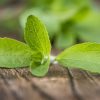
AsianScientist (Aug. 20, 2025) –Stevia is most well known as a zero-calorie sugar substitute, but it might do more than just sweeten your favorite drinks. Besides the steviol glycosides that give stevia its sweetness, stevia leaves also contain flavonoids and phenolic compounds with antioxidant and anti-inflammatory effects.
A team of Hiroshima University researchers have found that fermented stevia leaf extract (FSLE) contains a compound that can kill pancreatic cancer cells. The results of their study were published in the International Journal of Molecular Sciences.
“Globally, the incidence and mortality rates of pancreatic cancer continue to rise, with a five-year survival rate of less than 10%. Pancreatic cancer is highly invasive and prone to metastasis, showing significant resistance to existing treatments, such as surgery, radiotherapy and chemotherapy,”said the study co-author Narandalai Danshiitsoodol, associate professor in the Graduate School of Biomedical and Health Sciences at Hiroshima University. “As such, there is an urgent need to identify new and effective anticancer compounds, particularly those derived from medicinal plants.”
Previous research has shown that stevia leaf extract displays anti-cancer effects, but only with limited efficacy. The specific bioactive compounds that combat can cancer cells were difficult to isolate to be used for treatment.
“To enhance the pharmacological efficacy of natural plant extracts, microbial biotransformation has emerged as an effective strategy,” said the study’s corresponding author professor Masanori Sugiyama. The process of fermentation by microbes such as lactic acid bacteria (LAB) can alter the compounds available within stevia leaf extract, producing bioactive metabolites that might have more potent anti-cancer effects.
“In this study, we aimed to compare LAB-fermented and non-fermented extracts to identify key compounds that enhance bioactivity, ultimately contributing to the efficacy of herbal medicine in cancer prevention and therapy,” said Sugiyama.
The researchers fermented stevia leaf extract using Lactobacillus plantarum (strain SN13T). They then applied the FSLE to pancreatic cancer (PANC-1) cells and healthy human embryonic kidney cells (HEK-293), comparing its effects to that of non-fermented stevia leaf extract.
“Our findings indicate that FSLE demonstrates significantly greater cytotoxicity than the non-fermented extract at equivalent concentrations, suggesting that the fermentation process enhances the bioactivity of the extract,” Sugiyama said. Notably, the FSLE had minimal effects on the healthy kidney cells even at high concentrations, making it a promising candidate to treat pancreatic cancer.
Chemical analysis revealed that chlorogenic acid in the stevia leaf extract was converted into chlorogenic acid methyl ester (CAME) through fermentation. “This microbial transformation was likely due to specific enzymes in the bacteria strain used,” said Danshiitsoodol. Applied to pancreatic cancer cells, CAME inhibited cell division and induced cell death. While chlorogenic acid can also inhibit cancer cell proliferation, Danshiitsoodol noted, “Our data demonstrate that CAME exhibits stronger toxicity to cells and pro-apoptotic effects — which encourage cell death — on PANC-1 cells compared to chlorogenic acid alone.”
The researchers plan to conduct a mouse model study to understand how CAME might behave as a treatment in a whole-body system.
“The present study has substantially enhanced our understanding of the mechanism of action of the Lactobacillus plantarum SN13T strain in the fermentation of herbal extracts, while also offering a valuable research perspective on the potential application of probiotics as natural anti-tumour agents,” Danshiitsoodol said.
—
Source: Hiroshima University; Image: Shutterstock
This article can be found at: Stevia Leaf Extract Fermented with Plant-Derived Lactobacillus plantarum SN13T Displays Anticancer Activity to Pancreatic Cancer PANC-1 Cell Line
Disclaimer: This article does not necessarily reflect the views of AsianScientist or its staff.

